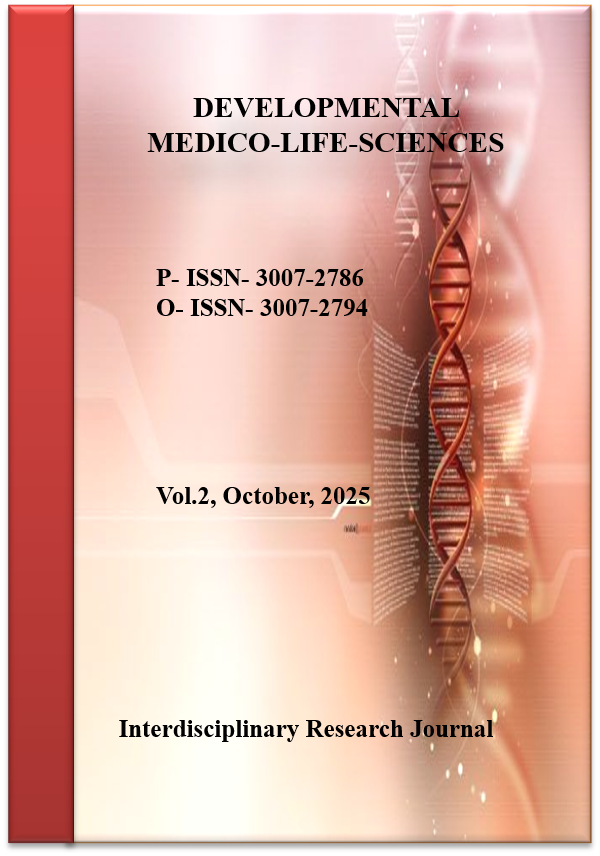Prevalence of Cardiovascular Risk Factors in Patients with Type 2 Diabetes Mellitus Attending Tertiary Care Hospitals
Prevalence of Cardiovascular Risk Factors in Type 2 Diabetes Patients
DOI:
https://doi.org/10.69750/dmls.02.010.0159Keywords:
Type 2 Diabetes Mellitus, Cardiovascular Risk Factors, Hypertension, Dyslipidemia, Obesity, PakistanAbstract
Background: Type 2 Diabetes Mellitus (T2DM) is a persistent metabolic illness that significantly enhances the chances of cardiovascular morbidity and death. Hypertension, dyslipidemia, obesity, smoking, and inadequate glycemic control are cardiovascular risk factors that are common in patients with diabetes, which increase complications of the disease. Determinants of their prevalence would be essential in formulating preventive and management programs, particularly in tertiary care environments where complex and uncontrolled cases would be commonly found.
Objective: To establish the prevalence and distribution of the most common risk factors in patients with Type 2 Diabetes Mellitus when they visit Shaikh Zayed Medical Complex.
Methods: The study was a descriptive cross-sectional study carried out between June 2024 and April 2025 in the Department of Endocrinology, Shaikh Zayed Medical Complex, Lahore. The number of patients enrolled was 90 adult T2DM patients aged 35 to 70 years, with a convenience sampling. Structured questionnaires and hospital records were used in the collection of demographics, clinical, and biochemical data. Hypertension, dyslipidemia, obesity, smoking, and poor glycemic control criteria were identified by the standard ADA 2024. The data were analyzed in SPSS version 26, and the results were presented in mean, SD, and percentages.
Results: The average age of the participants stood at 54.73/8.56 years old, and the proportion of males and females was 57.8/42.2. The hypertension and dyslipidemia were 72.2 and 71.1, respectively; obesity was 44.4; poor glycemic control (HbA1c >7) was 75.6; and smoking was 27.8, respectively. Clustering of risk factors was frequent- 71.1% of the participants had two or more cardiovascular risk factors, and 21.1% had three or more risk factors at the same time. Females were much more likely to be obese (p = 0.04) and males to smoke (p < 0.001).
Conclusion: T2DM patients had a high prevalence of modifiable cardiovascular risk factors, with the predominant ones being hypertension, dyslipidemia, and lack of glycemic control. There is a real need to combine screening, risk stratification, and lifestyle modification programs in managing diabetes to avoid the occurrence of cardiovascular complications in the future due to the co-existence of multiple risk factors.
Downloads
References
Cardoso H, Tavares Bello C, Andrade L, Sobral do Rosário F, Louro J, Nogueira C, et al. High prevalence of cardiovascular disease and risk factors among type 2 diabetes patients followed in a hospital setting in Portugal: the PICT2RE observational study. Rev Port Cardiol. 2023;42(4):319–330. doi:10.1016/j.repc.2022.04.011.
Regassa LD, Tola A, Ayele Y. Prevalence of cardiovascular disease and associated factors among type 2 diabetes patients in selected hospitals of Harari Region, Eastern Ethiopia. Front Public Health. 2020;8:532719. doi:10.3389/fpubh.2020.532719.
Khanal MK, Bhandari P, Dhungana RR, Gurung Y, Rawal LB, et al. Poor glycemic control, cardiovascular disease risk factors and their clustering among patients with type 2 diabetes mellitus: a cross-sectional study from Nepal. PLoS One. 2022;17(7):e0271888. doi:10.1371/journal.pone.0271888.
Joshi R, Subedi P, Yadav GK, et al. Prevalence and risk factors of chronic kidney disease among patients with type 2 diabetes mellitus at a tertiary care hospital in Nepal: a cross-sectional study. BMJ Open. 2023;13:e067238. doi:10.1136/bmjopen-2022-067238.
Alduraywish SA, Aldakheel FM, Azizalrahman LA, Alzaid LT, Alqahtani SS, Alhussein SH, et al. Knowledge about the risk of cardiovascular disease among adults with type 2 diabetes visiting outpatient clinics at a tertiary hospital in Riyadh, Saudi Arabia: a cross-sectional study. Int J Environ Res Public Health. 2022;19:4996. doi:10.3390/ijerph19094996.
Sahoo J, Mohanty S, Kundu A, et al. Medication adherence among patients with type II diabetes mellitus and its associated risk factors: a cross-sectional study in a tertiary care hospital of Eastern India. Cureus. 2022;14(12):e33074. doi:10.7759/cureus.33074.
Basil B, Mohammed JA, Mba IN, et al. High-sensitivity C-reactive protein and cardiovascular disease risk assessment in a population of type 2 diabetes mellitus patients. BMC Cardiovasc Disord. 2025;25:498. doi:10.1186/s12872-025-04975-3.
Alsaadon H, Afroz A, Karim A, et al. Hypertension and related factors among patients with type 2 diabetes mellitus: a multi-hospital study in Bangladesh. BMC Public Health. 2022;22:198. doi:10.1186/s12889-022-12509-1.
Dulyapach K, Ngamchaliew P, Vichitkunakorn P, Sornsenee P, Choomalee K. Prevalence and associated factors of delayed diagnosis of type 2 diabetes mellitus in a tertiary hospital: a retrospective cohort study. Int J Public Health. 2022;67:1605039. doi:10.3389/ijph.2022.1605039.
Bawah AT, Darko R, Abaka-Yawson A, et al. Dyslipidemia and its associated factors in patients with type 2 diabetes mellitus. J Public Health (Berl). 2021;29:985–991. doi:10.1007/s10389-020-01205-2.
Ahmed MA, Ferede YM, Takele WW. Incidence and predictors of chronic kidney disease in type II diabetes mellitus patients attending Amhara region referral hospitals, Ethiopia: a follow-up study. PLoS One. 2022;17(1):e0263138. doi:10.1371/journal.pone.0263138.
Bideberi AT, Mutagaywa R. Statin prescription patterns and associated factors among patients with type 2 diabetes mellitus attending diabetic clinic at Muhimbili National Hospital, Dar es Salaam, Tanzania. Diabetes Metab Syndr Obes. 2022;15:633–646. doi:10.2147/DMSO.S347765.
Shuvo SD, Hossen MT, Riazuddin M, et al. Prevalence of comorbidities and associated factors among type 2 diabetes patients: a hospital-based study in Jashore District, Bangladesh. BMJ Open. 2023;13:e076261. doi:10.1136/bmjopen-2023-076261.
Pitso L, Mofokeng TR, Nel R. Dyslipidaemia pattern and prevalence among type 2 diabetes mellitus patients on lipid-lowering therapy at a tertiary hospital in central South Africa. BMC Endocr Disord. 2021;21:159. doi:10.1186/s12902-021-00813-7.
Mehta RK, Koirala P, Mallick RL, Parajuli S, Jha R. Dyslipidemia in patients with type 2 diabetes mellitus in a tertiary care centre: a descriptive cross-sectional study. JNMA J Nepal Med Assoc. 2021;59(236):305–309. doi:10.31729/jnma.6278.
Haque A, Hasan MJ, Ahmed TU, Ali MY. Prevalence of type 2 diabetes mellitus among hypertensive patients attending a tertiary-level hospital in Bangladesh. Community Based Med J. 2025;14(2):121–125. doi:10.3329/cbmj.v14i2.83279.
Namdeo MK, Verma S, Das Gupta R, et al. Depression and health-related quality of life of patients with type 2 diabetes attending tertiary level hospitals in Dhaka, Bangladesh. Glob Health Res Policy. 2023;8:43. doi:10.1186/s41256-023-00328-9.
Shillah WB, Yahaya JJ, Morgan ED, et al. Predictors of microvascular complications in patients with type 2 diabetes mellitus at regional referral hospitals in the central zone, Tanzania: a cross-sectional study. Sci Rep. 2024;14:5035. doi:10.1038/s41598-024-55556-x.
Tamene FB, Zeleke TK, Desalew AF, et al. Polypharmacy and associated factors among patients with type 2 diabetes mellitus with comorbidity: a multicenter cross-sectional study in Northwest Ethiopia. BMC Endocr Disord. 2025;25:188. doi:10.1186/s12902-025-02011-1.
Rupasinghe S, Jayasinghe IK. Prevalence and associated factors of anaemia in patients with type 2 diabetes mellitus: a cross-sectional study in a tertiary care medical unit, Sri Lanka. BMC Endocr Disord. 2024;24:156. doi:10.1186/s12902-024-01681-7.






















